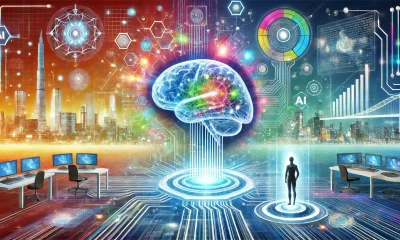Artificial Intelligence
Deep Learning vs Reinforcement Learning

Deep Learning and Reinforcement Learning are two of the most popular subsets of Artificial intelligence. The AI market was about $120 billion in 2022 and is increasing at a mind-boggling CAGR above 38%. As artificial intelligence evolved, these two approaches (RL and DL) have been used to solve many problems, including image recognition, machine translation, and decision-making for complex systems. We will explore how they work along with their applications, limitations, and differences in an easy-to-understand way.
What is Deep Learning (DL)?
Deep Learning is the subset of machine learning in which we use Neural Networks to recognize patterns in the given data for predictive modeling on the unseen data. The data can be tabular, text, image, or speech.
Deep Learning emerged in the 1950s when Frank Rosenblatt wrote a research paper on Perceptron in 1958. Perceptron was the first neural network architecture that could be trained to perform linear supervised learning tasks. Over time, research in the field, the availability of the massive amount of data, and extensive computational resources have further up roared the deep learning field.
How Deep Learning Works?
Neural Network is the building block of deep learning. The human brain inspires the Neural Network; It contains nodes (neurons) that transmit information. A neural network has three layers:
- Input Layer
- Hidden Layer
- Output Layer.
The input layer receives data given by the user and passes it to the hidden layer. The hidden layer performs a non-linear transformation on the data, and the output layer displays the results. The error between the prediction at the output layer and the actual value is computed using a loss function. The process continues iteratively until the loss is minimized.

Types of Deep Learning Architectures
There are various types of neural network architectures, such as:
- Artificial Neural Networks (ANN)
- Convolutional Neural Networks (CNN)
- Recurrent Neural Networks (RNN)
- Generative Adversarial Networks (GAN), etc.
The usage of a neural network architecture depends on the type of problem under consideration.
Applications of Deep Learning
Deep Learning finds its applications in many industries.
- In Healthcare, Computer Vision based methods employing convolutional neural networks can be used for analyzing medical images, e.g., CT and MRI scans.
- In the finance sector, it can predict stock prices and detect fraudulent activities.
- Deep Learning methods in Natural Language Processing are used for machine translation, sentiment analysis, etc.
Limitations of Deep Learning
Although deep learning has achieved the state of the art results in many industries, it has its limitations, which are as follows:
- Huge Data: Deep Learning requires a massive amount of labeled data for training. The lack of labeled data will give subpar results.
- Time-consuming: It can take hours and sometimes days to train on the dataset. Deep learning involves a lot of experimentation to reach the required benchmark or achieve tangible results, and a lack of rapid iteration can slow down the process.
- Computational Resources: Deep Learning requires computational resources like GPUs and TPUs for training. Deep learning models occupy ample space after training, which can be an issue during deployment.
What is Reinforcement Learning (RL)?
Reinforcement Learning, on the other hand, is the subset of artificial intelligence in which an agent performs an action on its environment. “Learning” happens by rewarding the agent when it undergoes the desired behavior and penalizing it otherwise. With experience, the agent learns the optimal policy to maximize the reward.
Historically, reinforcement learning got the spotlight in the 1950s and 1960s because decision-making algorithms were developed for complex systems. Therefore research in the field has led to new algorithms such as Q-Learning, SARSA, and actor-critic, which furthered the practicality of the area.
Applications of Reinforcement Learning
Reinforcement Learning has notable applications in all major industries.
- Robotics is one of the most celebrated applications in reinforcement learning. Using reinforcement learning methods, we allow robots to learn from the environment and perform the required task.
- Reinforcement Learning is used to develop engines for games like Chess and Go. AlphaGo (Go engine) and AlphaZero(chess engine) are developed using reinforcement learning.
- In finance, reinforcement learning can assist in making a profitable trade.
Limitations of Reinforcement Learning
- Huge Data: Reinforcement Learning requires a large amount of data and experience to learn an optimal policy.
- Reward Exploitation: It is important to maintain a balance between exploring the state, forming the optimal policy, and exploiting the knowledge obtained to increase the reward. The agent will not reach the best outcome if exploration is subpar.
- Safety: Reinforcement Learning raises safety concerns if the reward system is not designed and appropriately constrained.
Salient Differences
In a nutshell, salient differences between Reinforcement Learning and Deep Learning are as follows:
| Deep Learning | Reinforcement Learning |
| It contains interconnected nodes, and learning happens by minimizing the loss by adjusting the weights and biases of neurons. | It contains an agent that learns from the environment by interacting with it to reach optimal policy. |
| Deep Learning is used in supervised learning problems where data is labeled. Howover, it is used in unsupervised learning for use cases like anomaly detection, etc. | Reinforcement Learning involves an agent that learns from its environment without needing labeled data. |
| Used in object detection and classification, machine translation and sentiment analysis, etc. | Used in robotics, games, and autonomous vehicles. |
Deep Reinforcement Learning – The Combination
Deep Reinforcement Learning emerged as a new technique that combines reinforcement and deep learning methods. The latest chess engine, such as AlphaZero, is an example of Deep Reinforcement Learning. In AlphaZero, Deep Neural Networks employ mathematical functions for the agent to learn to play chess against itself.
Every year, big players in the market develop new research and products in the market. Deep Learning and Reinforcement Learning are expected to astound us with cutting-edge methods and products.
Want more AI-related content? Visit unite.ai.














